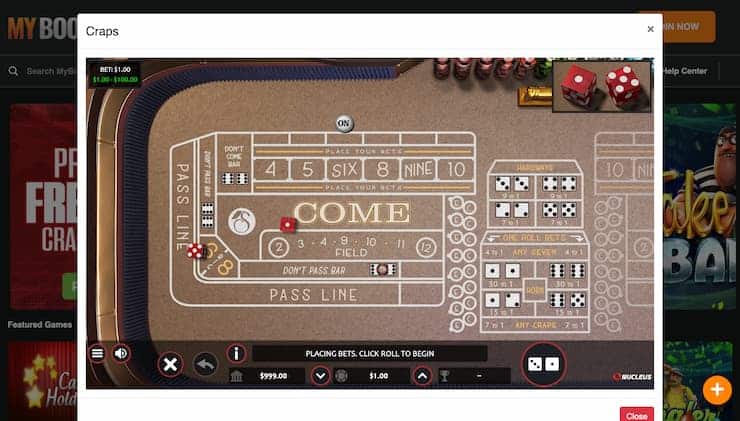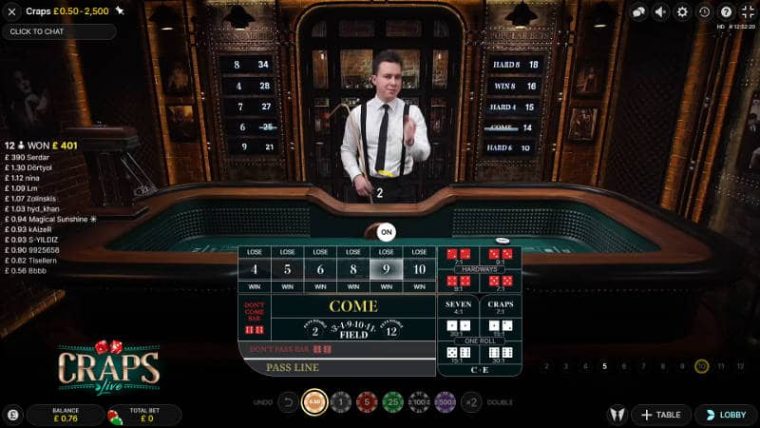Craps bankroll management helps determine how much and how often you’ll wager, bringing order to a completely random game. Learning this budgeting skill may just give you the best chance of long-term success.
Read on for money management tips from our pro craps players along with guidance on how to set a budget, manage bet sizes, and learn which strategies to avoid when playing craps to maximize your winning chances.
Why Craps Bankroll Management is Important
The only ‘skill’ that exists with this game is craps bankroll management. Setting a sensible money management strategy, using well-judged stakes, and sticking to the smart bets are the only chances you have to improve your chances of winning.
As with all casino bankroll management tips, the odds are against you here due to the built-in house edge. That stands at 1.41% and 1.36% for Pass and Don’t Pass bets respectively. Basically, you’re already starting at a disadvantage.
You can get lucky and overcome this, but – if you fail to manage your bankroll correctly – you’re giving the house even more of an edge, and yourself a bigger hurdle to overcome. Most likely, you’ll end up betting too much, and blowing up your betting account in little time at all.
Understanding the Game of Craps

The first part of turning a profit is actually understanding how to play craps. We don’t just mean the basic concept, either. To ensure successful craps bankroll management, you must fully understand the rules.
The Rules
Craps gameplay is straightforward. Craps players – the ‘shooter’ – roll two dice onto a table. Before that happens, all players must place their bets. The outcome of the dice roll then determines who wins. Each roll counts as a ‘round’ of craps, and – in general – up to 20 players can join one table.
The actual betting is where things get more involved.
You have two basic bets here – you can bet on the ‘pass line’ or ‘don’t pass’. The former means betting on a 7 or 11 being rolled before a 2, 3, or 12. The latter means betting on a combined 2 or 3 coming up before 7 or 11, with a 12 being a push (and your bet carrying over).
If 2 or 3, or 7 or 11 are rolled, those bettors get paid out, and the round is over. A 12 is a push for Don’t Pass players. If any other number is rolled (4,5,6,8,9, or 10), that becomes the ‘point’.
If either the pass line bet or don’t pass, or that ‘point’ is hit on the next roll, the round is over. If not, craps players keep going until a 7 or point is hit. It’s worth noting that you can also bet on points hitting, even after placing your initial wager. This is called a ‘come bet.’
Learn more about the game in our craps guides:
Your Chances
For the initial roll, there are six different probabilities to take into account (since 2 and 12, 3 and 11, 4 and 10, and so on all have the same chances). As you likely know, 7 is the most likely number to hit, at a 16.66% chance. Next are 6 and 8 at 13.89%, and so on down the line. 2 and 12 have a mere 2.78% probability of landing.
Statistically, your best bet is to pass the line. Your chances of rolling a ‘natural’ (a 7 or 11) are 22.22%, while you only have a 11.12% chance of getting a 2, 3, or 12.
Even if you don’t win your bet on the first go, and a point is rolled instead, you have a 49.29% chance overall of winning when you place a Pass bet. A Don’t Pass wager, however, only has a 47.93% chance of winning in the end.
Crucially, your payout in both cases will be the same – 1:1 (evens). As such, a Pass bet is simply the smarter play.
Luck vs Skill
Craps is a game of complete and utter chance. Unlike with blackjack bankroll management, for example, craps players have no impact whatsoever on the actual outcome of each game. Dice are rolled, and the results are random.
Setting A Budget for Playing Craps
Before you can start using well-judged stakes at online craps casinos, you need to determine what your overall budget is. This should be the very first thing you do, before loading up a single craps game.
Here are three of the most important factors for your calculation:
- Your Finances – Your craps bankroll needs to be directly proportional to your income. A good general guideline here is the 50/30/20 rule, with those percentages being for necessities, savings, and enjoyment. Craps falls into the third category, not the second. Treat this as you might spending money on a restaurant, or cinema trip – it’ll be fun, but don’t ‘expect’ to get any of your money back.
- Your Chances – Generally, this should make you cautious in how much you spend here. With the likes of a poker bankroll, you might reasonably back yourself to play the game well, especially as you get more experienced, and be more aggressive with your spending. With craps, because of the house edge, that’s not really a factor. In short, it might sound negative, but… assume you’re going to lose this money, and be pleasantly surprised if you don’t.
- Your Experience Level – Due to the nature of the game, you won’t get ‘better’ at craps. You will, however, grow more comfortable with the game, particularly learning about the bets you can use and when you should do so. As such, we’d recommend starting out with a comparatively low budget, rather than charging in like a pro craps player, even if you can afford to deposit more. As you grow more confident, you can always add more money to your account and – in turn – increase the size of your potential profits.
Bet Size Strategies for Craps

After setting your overall budget, you need to decide how much you’re actually going to be betting. There are two main ways to do this.
Splitting Your Session Bankroll
The first option is to split your entire bankroll into units. Generally speaking, it’s a good rule of thumb to have at least 100 units. So, if you’re pursuing a $200 craps strategy, each unit would be $2.
While this will see you use smaller stakes than you otherwise might, and therefore gain lower profits, it also gives you a cushion against losing streaks. With our $200 example, if you’re betting $50 per go, then a mere four losses could wipe you out. If you’re only betting $2 per round, five losses would be nothing at all to worry about.
The second is to use session bankrolls, and work from there. A ‘session’ is simply when you play at the craps table for an extended period of time, rather than just one or two rounds.
This approach is not incompatible with the first one. It simply means splitting up your money a little differently.
Rather than calculating your stakes based on your entire bankroll, you instead base them on a craps session bankroll. If you say you’re going to have four sessions per month, for example, you can split your whole bankroll into four, and calculate your 100 units from there.
Placing Bets
Now you know your general unit sizes. Now, let’s recap the actual bets you can place them on.
There are four main bet types here:
- Pass Line – Bet on a 7 or 11 coming up, before a 2, 3, or 12. This bet has the best house edge.
- Don’t Pass Line – Bet on a 2 or 3 landing before a 7 or 11. 12 is a push (your stake carries over). 0.05% worse house edge than the Pass Bet.
- Come Bet – After a point has been set, you’re betting on a 7 or 11 landing before that point.
- Don’t Come Bet – Betting on a 2 or 3 landing after a point has been set (12 is still a push)
In addition, there are a number of other wagers you can place during craps play. While these do tend to have higher odds, they also have significantly higher houses built-in, and shouldn’t be considered as anything more than high risk, high reward gambles.
Managing Wins & Losses

As with any game of chance, you’ll go through good times and bad at the craps table. Here are four tips to help you deal with those ups and downs.
Don’t Chase Losses
Chasing after losses is easily one of the biggest temptations in gambling. Don’t fall prey to it. Your decision-making after you’ve lost a few wagers will naturally be worse, and you’re more likely to make impulsive bets. It’s far better to just step back, take a break from the craps table, then come back refreshed.
Remember Gambler’s Fallacy
Related to our previous point, don’t fall prey to Gambler’s Fallacy. This is the belief that prior results have any impact at all on future outcomes. They don’t. Every single roll of the dice is completely random, and the likes of hot and cold streaks don’t exist. Forget all of that, and just keep the actual statistical chances firmly in mind instead.
Have Limits In Place
Craps bankroll strategies don’t have to end with you losing all your money, nor should you chase after profits indefinitely. Instead, you can set both a sensible loss limit and a realistic profit target for yourself. When your bankroll hits either figure, the session is over and you walk away.
Stay Grounded
It’s not just suffering losses that you need to watch out for. There can also be a tendency to get carried away when things are going well too, and start ramping up your stakes. This must also be resisted, since it can open you up to big-time losses, and result in you giving back all your profits.
Betting Systems in Craps to Avoid
It’s easy to see the appeal of betting systems. They give structure to your gambling, tell you how many units to use for a minimum bet, and can either ramp up your profits or recoup your losses, depending on whether they’re a positive or negative progression system.
It’s debatable whether they’re actually effective for craps, however. The fact that Pass and Don’t Pass bets are both even-odds means that they will fit into most betting systems, like the Martingale System, Fibonacci, and so on.
We can’t ignore, however, that players have a built-in disadvantage. Even with a solid system in place to guide your staking, therefore, the statistical chances are still against you in the long run.
Final Thoughts
Craps is a simple game of chance, which has been enjoyed for centuries.Managing your bankroll to place bets won’t actually improve your chances of winning at craps tables. It will, however, keep you playing for a longer period of time, and remove the biggest risk of all – putting down ill-advised wagers which will likely blow up your betting account.
To get the ball rolling here, assess your finances sensibly and set your overall budget. You can then break this down into a number of smaller units – per bet, or per session – and must stick to these over the long haul.